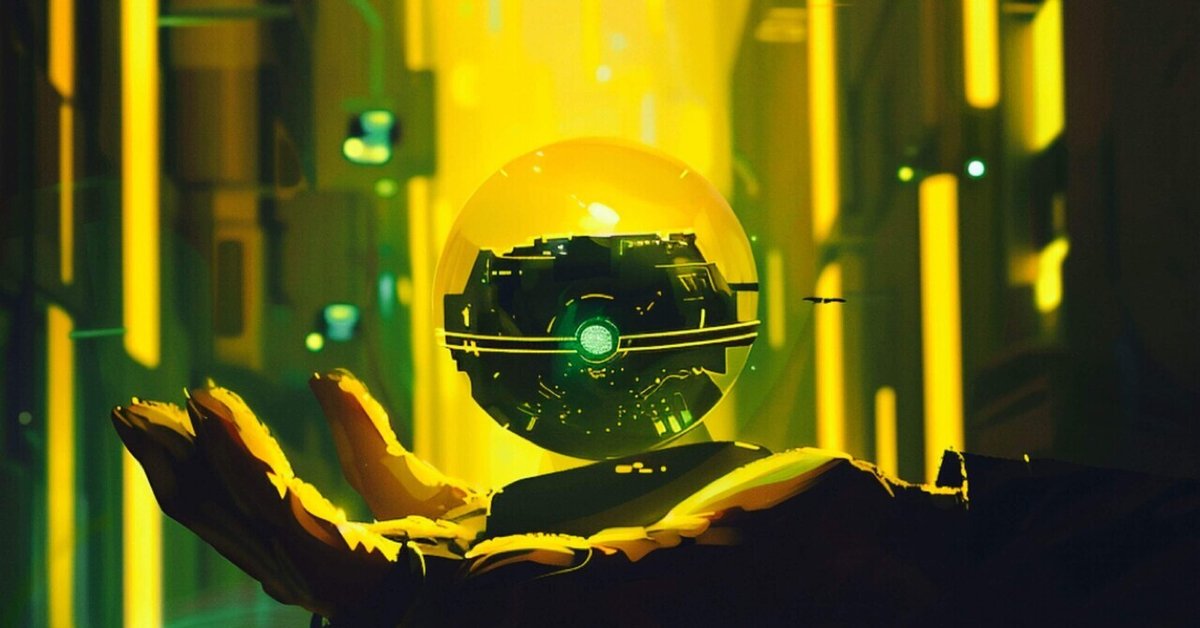
Tiny Time Machine : 妄想ショートショート078
◾️スマホの未来を考えるSFショートショート
※ Image BGM by Suno AI
この曲を聴きながら読んで下さい
小さなタイムマシン
賑やかなニューエデンの大都市に、パーソナル・デバイスの次の進化がついに現れた。”Tiny Time Machine : 小さなタイムマシン”は、手のひらに収まるほど小さく、人々の時間との関わり方を変えるほどパワフルな球形のデバイスである。かつてのスマートフォンとは異なり、このデバイスは単なるコミュニケーションや情報のツールではなく、個人の過去や潜在的な未来への入り口だった。
人々は長い間、写真、メッセージ、健康記録、その他数え切れないほどのデジタルフットプリントといった、膨大な量の個人データを蓄積してきた。Gen.AIの出現により、これらのデータポイントはもはや静的な記録データではなく、処理し、理解し、未来のシナリオを視覚化し、創造するために拡張することができる動的なデータとなった。
Tiny Time Machineは、謎めいたオーディオ・エンジニアであるÆchoの発案によるもので、彼のこれまでの作品は、すでに人々のサウンドスケープの捉え方に革命を起こしていた。この新しい発明で、Æchoは個人の歴史と未来の可能性という概念をシームレスな体験に融合させることを目指した。
未来体験
若い夢想家マーカスは、Tiny Time Machineをそっと持ち、半透明のコアを見つめた。装置は彼の存在を認めるように、やわらかくハミングした。彼は何年もかけて自分の夢、恐れ、成功、失敗を記録し、それをこの小さなオーブに送り込んできた。今日、彼は自分の未来が何をもたらすかを探求する準備ができていた。
「私の夢がかなう世界を見せてください」マーカスはささやいた。装置は明るく輝き、一瞬にして彼の周りの部屋は光と音の滝のように溶けていった。ニューエデンとさほど変わらないが、微妙な違い-より多くの緑、よりきれいな空気、より幸せそうな顔-がある。それは彼の願望によって形作られ、AIの洞察によって導かれた世界だった。
この思い描いた未来を歩きながら、マーカスは自分が革新的なプロジェクトを率い、まだ見ぬ頭脳と協力し、世界に具体的な影響を与えている姿を見た。それは単なる投影ではなく、彼が行ったすべての選択が生成AIによって分析・調整され、さまざまな結果を示すインタラクティブな体験だった。
Tiny Time Machineの素晴らしさは、単に視覚化するだけでなく、こうした未来の可能性を言語化する能力にあった。この装置は、マーカスの目標、恐れ、動機を、彼がこれまで完全に理解していなかった方法で明確に表現することができた。この装置と関わることで、彼は自分の野心を洗練させ、現在の行動を望む未来と一致させることができた。
マーカスは探求するうちに、この未来が保証された運命ではなく、自分の決断と努力によって形作られる可能性のある結果であることに気づいた。Tiny Time Machineはガイドであり、指導者であり、仲間であり、人生の不確実性を明瞭にし、目的を持って航海する手助けをしてくれた。
現在に戻ったマーカスは、決意を新たにした。未来は決まっていなかったが、Tiny Time Machineによって、彼は未来に向かう地図を手に入れたのだ。他の多くの人たちと同じように、自分もこの驚くべき装置の助けを借りて運命を切り開く力を持っていることを彼は知っていた。
2024/07/30
◾️妄想未来企画
このショートショートは、未来のパーソナルデバイスを夢想したSFプロトタイピングを意識したもの。
既に10〜15年もスマートフォンを使っていて感じるのは、過去の思い出がくっきりとした鮮明な記憶として記録されていること。ここに生成AIがこのパーソナルデバイスに当たり前に搭載されるようになると、何が起きるのだろうか?そんな問いをしてみた。
生成AIは、まだ起きていないことでも言語化やビジュアル化ができる。これがゲームチェンジを引き起こすトリガーになるのでは?と考えた。
つまり、我々の手のひらの上には、過去のデータベースに加えて未来創造の力が宿ることになる。
これを"Time Machine"と呼んでも良いのでは無いだろうか?
一人ひとりがタイムマシンを持つ未来
“Tiny Time Machine”は、人々が自ら望む未来を描き、自ら行動を選択し生きていける世界を生み出す。
“Tiny Time Machine”が広く普及する未来を想像すると、社会や個人の生活にさまざまな影響をもたらすことが考えられる。その未来は、多くの面で現在とは異なる世界となるだろう。
◾️個人の生活の変化
個人の成長と自己理解の深化
- 人々は自分の過去を深く理解し、それをもとに未来を計画することができるようになる。これにより、個人の成長が促進され、自己理解が深まる。
- 未来の可能性を視覚化・体験することで、自分の目標や夢に具体的なイメージを持つことができる。
意思決定の精度向上
- 人々は未来のシナリオをシミュレートすることで、より情報に基づいた意思決定が可能になる。重要な選択をする際に、長期的な影響を視覚化できるため、リスク管理や戦略的計画が向上する。
ストレスと不安の軽減
- 未来の可能性を具体的に見ることで、漠然とした不安やストレスが軽減される。人々は自分の進むべき道をより明確に理解し、安心感を持って日常生活を送ることができる。
◾️社会の変化
教育の革新
- 学校や教育機関では、個々の学生が自分の未来のビジョンを持ちながら学ぶことが奨励される。学生たちは、自分の興味や目標に合わせた学習計画を立て、より意欲的に学ぶことができるようになる。
キャリアパスの多様化
- 未来のシナリオを探索することで、従来のキャリアパスに縛られない多様な職業選択が可能になる。人々は新しい分野や興味を発見し、柔軟にキャリアを築くことができる。
社会福祉の向上
- 個々の将来の健康状態や生活環境を予測することで、社会福祉サービスがより効果的に提供される。例えば、高齢者の介護計画や健康維持プログラムがよりパーソナライズされ、効果的に運用されるようになる。
◾️経済の変化
市場ダイナミズムの増加
- 未来のトレンドや需要を可視化することで、企業はより迅速かつ柔軟に市場の変化に対応できるようになる。新しいビジネスモデルや製品が次々と生まれ、経済が活性化する。
持続可能な発展
- 環境への影響や資源の使用を予測することで、より持続可能なビジネスプラクティスが導入される。企業や政府は、長期的な視点で環境保護や資源管理を行うようになる。
◾️文化と価値観の変化
未来志向の価値観の醸成
- 人々は未来の可能性を積極的に考え、行動するようになる。これにより、社会全体がより未来志向の価値観を持つようになり、革新や挑戦が奨励される文化が形成される。
多様性と包摂性の拡大
- 個々の未来ビジョンが尊重され、多様な生き方や価値観が受け入れられる社会が構築される。これにより、より包括的で平等な社会が実現する。
◾️科学技術の発展
AIと人間の協働
- Generative AIやDelusional Technologyの進化により、人々はAIと協働しながら未来を設計し、実現する能力を持つようになる。これにより、AIは単なるツールではなく、共創パートナーとして位置づけられる。
新技術の迅速な実用化
- 未来シナリオの視覚化を通じて、新技術の実用化が加速される。技術革新が迅速に社会に浸透し、生活の質が向上する。
Development Roadmap
Estimated Timeline
- 2024-2026: Foundation Phase
- 2027-2029: Development Phase
- 2030-2032: Testing and Refinement Phase
- 2033-2035: Launch Phase
To create a roadmap for making the "Tiny Time Machine" a reality, we need to consider several key milestones and the development of specific technologies. Here's a detailed plan, outlining the necessary steps and the estimated timeline:
2024-2026: Foundation Phase
Advanced AI Algorithms
Objective:
Develop and refine generative AI algorithms capable of processing and interpreting vast amounts of personal data.
Technologies:
- Machine learning and deep learning frameworks.
- Natural Language Processing (NLP) for better understanding and generation of human language.
- Enhanced data privacy and security protocols to protect user data.Data Integration and Personalization
Objective:
Create systems that can integrate diverse data sources (social media, health records, personal documents) into a cohesive personal dataset.
Technologies:
- Big data analytics platforms.
- Personalized recommendation engines.
- Secure cloud storage solutions
2027-2029: Development PhaseDelusional Technology Development
Objective:
Develop the technology that can seamlessly blend personal data with generative AI to create immersive and interactive future scenarios.
Technologies:
- Augmented Reality (AR) and Virtual Reality (VR) systems for immersive experiences.
- Advanced simulation software to model potential future scenarios.
- Human-computer interaction (HCI) improvements for intuitive user interfaces.Prototype Creation
Objective:
Design and test the initial prototype of the Tiny Time Machine.
Technologies:
- Miniaturization of hardware components.
- Energy-efficient processors and batteries.
- High-resolution, small-scale displays.
2030-2032: Testing and Refinement PhaseUser Testing and Feedback
Objective:
Conduct extensive user testing to gather feedback and refine the device.
Technologies:
- User experience (UX) research tools.
- Data analysis tools for feedback interpretation.
- Iterative design and development platforms.Scalability and Production
Objective:
Scale up production capabilities to meet potential market demand.
Technologies:
- Advanced manufacturing techniques.
- Supply chain optimization tools.
- Quality control and assurance systems.
2033-2035: Launch PhaseMarket Introduction
Objective:
Launch the Tiny Time Machine to the public.
Technologies:
- Marketing and distribution channels.
- Customer support infrastructure.
- Continuous monitoring and update systems.
Key Technologies to Develop
1. Generative AI and Machine Learning
- Capable of understanding and expanding on personal data.
2. Natural Language Processing (NLP)
- For accurate communication and language generation.
3. Data Privacy and Security
- Ensuring user data is protected at all times.
4. Augmented Reality (AR) and Virtual Reality (VR)
- For creating immersive future scenarios.
5. Simulation Software
- To model complex future scenarios based on personal data.
6. Human-Computer Interaction (HCI)
- For intuitive and seamless user interfaces.
7. Miniaturized Hardware
- Compact, energy-efficient components for the device.
+Applications of Statistical Mechanics
The interface and functionality of the "Tiny Time Machine" can be achieved very effectively through the application of statistical mechanics. Statistical mechanics is a theory for understanding the behavior of large systems in terms of the statistical properties of individual elements, and is very useful in simulating future scenarios.
Examples of applications of statistical mechanics
1. simulation of future scenarios
- Statistical mechanics is used to model the interaction of a large number of data points and variables to predict possible future scenarios.
- The impact of individual choices and actions on the system as a whole is analyzed and an optimal future scenario is presented.
2. Prediction of Emotion and Behavior
- Using statistical methods, we analyze users' emotions and behavior patterns from past data to predict future behavior.
- This provides appropriate feedback and advice based on the user's current emotional state and behavior.
3. System optimization
- Optimize device performance and energy efficiency using statistical mechanics.
- Optimize system behavior based on user usage patterns to improve battery life and processing speed.
4. Real-time data analysis
- Analyzes data in real-time using algorithms based on statistical mechanics to update future scenarios.
- Processes large amounts of data quickly and dynamically adjusts its interface to changing conditions.
Specific statistical mechanics techniques
1. Monte Carlo simulation
- A technique that generates a large number of random samples and simulates the behavior of a system. Generates a large number of future scenarios and helps to select the most likely scenario.
2. Markov Chain Monte Carlo (MCMC) Method
- A method that uses Markov chains to sample complex probability distributions. It models the probability distribution of future states and makes long-term forecasts.
3. Molecular dynamics simulation
- Extends the method to simulate interactions at the molecular level and applies it to analyze the behavior of social and economic systems. Models the impact of individual choices on the whole.
4. Statistical Machine Learning
- Trains machine learning models using statistical methods to learn patterns from data. This enables prediction of individual user behavior and optimal interface adjustments.
Conclusion
By applying the principles of statistical mechanics, the "Tiny Time Machine" can achieve more precise and accurate future predictions and scenario simulations. This will enable users to make better decisions and maximize future possibilities. The application of statistical mechanics also contributes to improved device performance and user experience, providing a more intuitive and effective interface.
